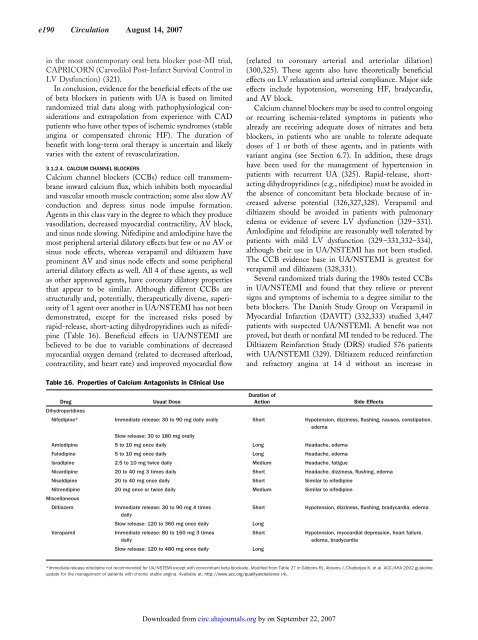ACC/AHA 2007 guideline update for the
ACC/AHA 2007 guideline update for the
ACC/AHA 2007 guideline update for the
You also want an ePaper? Increase the reach of your titles
YUMPU automatically turns print PDFs into web optimized ePapers that Google loves.
e190 Circulation August 14, <strong>2007</strong><br />
in <strong>the</strong> most contemporary oral beta blocker post-MI trial,<br />
CAPRICORN (Carvedilol Post-Infarct Survival Control in<br />
LV Dysfunction) (321).<br />
In conclusion, evidence <strong>for</strong> <strong>the</strong> beneficial effects of <strong>the</strong> use<br />
of beta blockers in patients with UA is based on limited<br />
randomized trial data along with pathophysiological considerations<br />
and extrapolation from experience with CAD<br />
patients who have o<strong>the</strong>r types of ischemic syndromes (stable<br />
angina or compensated chronic HF). The duration of<br />
benefit with long-term oral <strong>the</strong>rapy is uncertain and likely<br />
varies with <strong>the</strong> extent of revascularization.<br />
3.1.2.4. CALCIUM CHANNEL BLOCKERS<br />
Calcium channel blockers (CCBs) reduce cell transmembrane<br />
inward calcium flux, which inhibits both myocardial<br />
and vascular smooth muscle contraction; some also slow AV<br />
conduction and depress sinus node impulse <strong>for</strong>mation.<br />
Agents in this class vary in <strong>the</strong> degree to which <strong>the</strong>y produce<br />
vasodilation, decreased myocardial contractility, AV block,<br />
and sinus node slowing. Nifedipine and amlodipine have <strong>the</strong><br />
most peripheral arterial dilatory effects but few or no AV or<br />
sinus node effects, whereas verapamil and diltiazem have<br />
prominent AV and sinus node effects and some peripheral<br />
arterial dilatory effects as well. All 4 of <strong>the</strong>se agents, as well<br />
as o<strong>the</strong>r approved agents, have coronary dilatory properties<br />
that appear to be similar. Although different CCBs are<br />
structurally and, potentially, <strong>the</strong>rapeutically diverse, superiority<br />
of 1 agent over ano<strong>the</strong>r in UA/NSTEMI has not been<br />
demonstrated, except <strong>for</strong> <strong>the</strong> increased risks posed by<br />
rapid-release, short-acting dihydropyridines such as nifedipine<br />
(Table 16). Beneficial effects in UA/NSTEMI are<br />
believed to be due to variable combinations of decreased<br />
myocardial oxygen demand (related to decreased afterload,<br />
contractility, and heart rate) and improved myocardial flow<br />
Table 16. Properties of Calcium Antagonists in Clinical Use<br />
(related to coronary arterial and arteriolar dilation)<br />
(300,325). These agents also have <strong>the</strong>oretically beneficial<br />
effects on LV relaxation and arterial compliance. Major side<br />
effects include hypotension, worsening HF, bradycardia,<br />
and AV block.<br />
Calcium channel blockers may be used to control ongoing<br />
or recurring ischemia-related symptoms in patients who<br />
already are receiving adequate doses of nitrates and beta<br />
blockers, in patients who are unable to tolerate adequate<br />
doses of 1 or both of <strong>the</strong>se agents, and in patients with<br />
variant angina (see Section 6.7). In addition, <strong>the</strong>se drugs<br />
have been used <strong>for</strong> <strong>the</strong> management of hypertension in<br />
patients with recurrent UA (325). Rapid-release, shortacting<br />
dihydropyridines (e.g., nifedipine) must be avoided in<br />
<strong>the</strong> absence of concomitant beta blockade because of increased<br />
adverse potential (326,327,328). Verapamil and<br />
diltiazem should be avoided in patients with pulmonary<br />
edema or evidence of severe LV dysfunction (329–331).<br />
Amlodipine and felodipine are reasonably well tolerated by<br />
patients with mild LV dysfunction (329–331,332–334),<br />
although <strong>the</strong>ir use in UA/NSTEMI has not been studied.<br />
The CCB evidence base in UA/NSTEMI is greatest <strong>for</strong><br />
verapamil and diltiazem (328,331).<br />
Several randomized trials during <strong>the</strong> 1980s tested CCBs<br />
in UA/NSTEMI and found that <strong>the</strong>y relieve or prevent<br />
signs and symptoms of ischemia to a degree similar to <strong>the</strong><br />
beta blockers. The Danish Study Group on Verapamil in<br />
Myocardial Infarction (DAVIT) (332,333) studied 3,447<br />
patients with suspected UA/NSTEMI. A benefit was not<br />
proved, but death or nonfatal MI tended to be reduced. The<br />
Diltiazem Reinfarction Study (DRS) studied 576 patients<br />
with UA/NSTEMI (329). Diltiazem reduced reinfarction<br />
and refractory angina at 14 d without an increase in<br />
Drug<br />
Dihydropyridines<br />
Usual Dose<br />
Duration of<br />
Action Side Effects<br />
Nifedipine* Immediate release: 30 to 90 mg daily orally<br />
Slow release: 30 to 180 mg orally<br />
Short Hypotension, dizziness, flushing, nausea, constipation,<br />
edema<br />
Amlodipine 5 to 10 mg once daily Long Headache, edema<br />
Felodipine 5 to 10 mg once daily Long Headache, edema<br />
Isradipine 2.5 to 10 mg twice daily Medium Headache, fatigue<br />
Nicardipine 20 to 40 mg 3 times daily Short Headache, dizziness, flushing, edema<br />
Nisoldipine 20 to 40 mg once daily Short Similar to nifedipine<br />
Nitrendipine<br />
Miscellaneous<br />
20 mg once or twice daily Medium Similar to nifedipine<br />
Diltiazem Immediate release: 30 to 90 mg 4 times<br />
daily<br />
Short Hypotension, dizziness, flushing, bradycardia, edema<br />
Slow release: 120 to 360 mg once daily Long<br />
Verapamil Immediate release: 80 to 160 mg 3 times<br />
Short Hypotension, myocardial depression, heart failure,<br />
daily<br />
edema, bradycardia<br />
Slow release: 120 to 480 mg once daily Long<br />
*Immediate-release nifedipine not recommended <strong>for</strong> UA/NSTEMI except with concomitant beta blockade. Modified from Table 27 in Gibbons RJ, Abrams J, Chatterjee K, et al. <strong>ACC</strong>/<strong>AHA</strong> 2002 <strong>guideline</strong><br />
<strong>update</strong> <strong>for</strong> <strong>the</strong> management of patients with chronic stable angina. Available at: http://www.acc.org/qualityandscience (4).<br />
Downloaded from<br />
circ.ahajournals.org by on September 22, <strong>2007</strong>
















